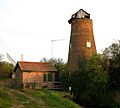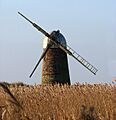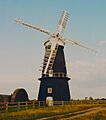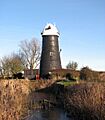List of drainage windmills in Norfolk facts for kids
Norfolk is a county in England known for its beautiful flat lands and many waterways. To keep these lands from flooding, people built special windmills called drainage windmills. These windmills don't grind grain like traditional windmills; instead, they pump water from low-lying areas into rivers and canals. This helps keep the land dry for farming and homes. Many of these historic windmills are looked after by the Norfolk Windmills Trust, making sure they stay standing for future generations to see.
Contents
- What are Drainage Windmills?
- Famous Drainage Windmills in Norfolk
- Acle's Historic Mills
- Barton Turf and Belton's Landmarks
- Mills of the Broads: Catfield and Chedgrave
- Fritton's Collection of Mills
- Great Yarmouth and Halvergate's Giants
- Hickling and Horning's Historic Pumps
- Langley, Limpenhoe, and Ludham's Legacy
- Martham and Mautby's Mills
- Nordelph and Norton Subcourse's Smock Mills
- Potter Heigham and Reedham's Water Movers
- Runham and Smallburgh's Structures
- Stalham, Starston, and Stokesby's Towers
- Thurne, Tunstall, and Upton's Mills
- Waxham and West Somerton's Mills
- Images for kids
What are Drainage Windmills?
Drainage windmills are like big water pumps powered by the wind. They have large sails that catch the wind, turning machinery inside that lifts water. This water is then moved from wet marshlands into higher rivers or drains, preventing floods. They were super important before electric pumps were invented, helping farmers grow crops and people live safely in areas that would otherwise be underwater.
Types of Windmills You'll Find
There are a few main types of drainage windmills you might see in Norfolk:
- Tower Mills: These are the most common type. They have a tall, round stone or brick tower. The top part, called the cap, can turn to face the wind, moving the sails with it.
- Hollow Post Mills: These are older and simpler. They have a central wooden post that is hollow. The machinery that pumps the water goes through this hollow post. The whole mill body turns to face the wind.
- Trestle Mills: These are similar to hollow post mills but often have a more open, wooden frame (a "trestle") at the base to support the main body.
Famous Drainage Windmills in Norfolk
Norfolk is home to many amazing drainage windmills. Here are some of the most well-known ones:
Acle's Historic Mills
The area around Acle has been important for drainage for a long time.
- Charlie Water's Mill is a tower mill that helped keep the land dry.
- Palmer's Mill was a hollow post mill. It was taken apart in 1976 and then rebuilt in Upton in 1978, showing how much people value these old structures.
Barton Turf and Belton's Landmarks
- Turf Fen Windpump near Barton Turf is a tower mill built around 1875. It's a great example of these historic pumps.
- In Belton, you can find Black Mill, a tower mill built around 1830. These mills often get their names from their appearance or location.
Mills of the Broads: Catfield and Chedgrave
The Norfolk Broads area is full of drainage mills.
- Swim Coots Mill in Catfield is a tower mill from 1838. It's a key part of the Broads landscape.
- Near Chedgrave, Six Mile House and Pettingell's Mill are both tower mills that have been pumping water for many years.
Fritton's Collection of Mills
Fritton has seen several types of mills over time.
- Caldecott Mill and Fritton Marshes mills are tower mills that have worked hard to drain the land.
- St Olaves Mill (also known as Priory Mill) is a trestle mill that was built around 1910.
Great Yarmouth and Halvergate's Giants
The area around Great Yarmouth and Halvergate has some impressive mills.
- Ashtree Farm Mill in Great Yarmouth is a tower mill that was built in 1912.
- Lockgate Mill, also near Great Yarmouth, is another tower mill, built in 1877.
- Halvergate is particularly rich in tower mills, including Six Mile House Mill, Key's Mill, Stone's Mill, Mutton's Mill, High's Mill, and South Walsham Mill. These mills worked together to manage water levels in the vast marshlands.
Hickling and Horning's Historic Pumps
- In Hickling, you'll find Hickling Windmill (Roland Green's Mill) from around 1860, and the impressive Stubb Mill from around 1800.
- Horning is home to Neave's Mill (Kettle's Mill), a tower mill built in 1810.
- Hobb's Mill in Horning is a trestle mill that was restored in 1983, showing its importance.
- The famous Horsey Windpump is a tower mill built in 1912. It's a well-known landmark and a great example of a working drainage mill.
Langley, Limpenhoe, and Ludham's Legacy
- Langley Detached Mill in Langley is a notable tower mill.
- Limpenhoe Mill in Limpenhoe is a tower mill dating back to 1831.
- Ludham has several interesting mills, including Boardman's Windmill (a trestle mill) and Clayrack Drainage Mill (a hollow post mill). Clayrack Mill was actually moved and rebuilt in 1987, showing how these structures can be preserved.
- Other Ludham mills include Womack Water and North Mill at Ludham Bridge, both tower mills.
Martham and Mautby's Mills
- Bracey's Mill in Martham is a tower mill built in 1908.
- Marsh Mill in Mautby is another important tower mill.
Nordelph and Norton Subcourse's Smock Mills
- Nordelph features Well Creek Mill and Upwell Fen Mill, both smock mills. Smock mills have a wooden, often octagonal, body that looks a bit like a smock (a type of shirt).
- In Norton Subcourse, Norton Marshes and Boyce's Mill are tower mills, built in 1863 and 1861 respectively.
Potter Heigham and Reedham's Water Movers
- Potter Heigham is home to High's Mill (c. 1875) and Heigham Holmes Mill, both tower mills vital for drainage.
- Reedham has many tower mills, including Cadge's Mill, Polkey’s Mill, and North Mill.
- The iconic Berney Arms Mill (also known as High Mill) is a very tall tower mill built in 1865. It's one of the most famous and impressive drainage mills in Norfolk.
Runham and Smallburgh's Structures
- In Runham, you'll find Five Mile House Mill (1849), Perry's Mill, and Child's Mill, all tower mills.
- Smallburgh has Wayford Bridge Mill (Dilham Dyke Mill), and Moy's Mill (1900-1937), which are important tower mills.
Stalham, Starston, and Stokesby's Towers
- Hunsett Mill in Stalham is a tower mill from 1860, a well-known and preserved example.
- Starston Windpump in Starston is a hollow post mill from around 1850.
- Stokesby has Commission Mill and Old Hall Mill (Dack's Mill), both tower mills.
Thurne, Tunstall, and Upton's Mills
- Thurne Dyke Mill (Morse's Mill) in Thurne is a tower mill built in 1820.
- Tunstall features the impressive Stracey Arms Windpump (1820) and Tunstall Dyke, both tower mills.
- In Upton, Palmer's Mill (rebuilt in 1978) is a hollow post mill, and Black Mill (1800) is a tower mill.
Waxham and West Somerton's Mills
- Brograve Mill in Waxham is a tower mill from 1771, a very old and important structure.
- West Marsh Mill in West Somerton is a tower mill built in 1858.
These windmills are not just old buildings; they are a vital part of Norfolk's history and show how people used clever engineering to live and farm in challenging environments.
Images for kids







































































